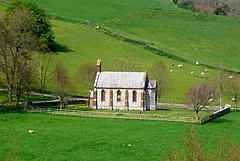Wynford Eagle
| Wynford Eagle | |
|---|---|
 Church of St Lawrence, Wynford Eagle | |
| Population | 60 [1] |
| OS grid reference | SY581959 |
| District | |
| Shire county | |
| Region | |
| Country | England |
| Sovereign state | United Kingdom |
| Post town | Dorchester |
| Postcode district | DT2 |
| Dialling code | 01305 |
| Police | Dorset |
| Fire | Dorset and Wiltshire |
| Ambulance | South Western |
| UK Parliament | |
Wynford Eagle is a hamlet and small parish in Dorset, England, situated in the West Dorset administrative district approximately 1.5 miles (2.4 km) southwest of Maiden Newton and 7.5 miles (12.1 km) northwest of Dorchester. Dorset County Council's 2013 mid-year estimate of the parish population is 60.[1]
Toponymy
The village was recorded as Wenfrot in the Domesday Book of 1086, and as Wynfrod Egle in 1288.[2] The name Wynford derives from the Celtic wïnn and frud, meaning a white or bright stream.[2] The affix Eagle derives from the 13th-century manorial family, described as being called either de Aquila,[3] de l'Aigle or del Egle.[2]
History
Wynford Eagle parish contains barrows, and Roman remains have been unearthed here, including mosaic pavements, which have led to its identification as a villa site. The parish used to be in the hundred of Tollerford.
In 1788 the village is mentioned in Owen's New Book of Fairs as having a yearly fair on the 21st of August, selling toys.[4]
Manor house
The manor house, now Manor Farm, rebuilt in 1630, was from 1551 for many years the seat of the Puritan Sydenham family, to which belonged the distinguished physician Thomas Sydenham (1624–1689). The family lost the property in scandalous circumstances, the last Sydenham owner dying in Dorchester prison in 1709.
The estate was later acquired by the Best family, originally of Somerset, for whom the title of Baron Wynford was created in 1829. The same family remain the principal landowners.
Church
The church of Saint Lawrence, formerly a chapelry of the church of Toller Fratrum, and later annexed to it as a perpetual curacy, was rebuilt in 1842 but preserves a striking Norman tympanum, carved with two wyverns, probably intended to represent eagles, as a pun on the name of Matilda de l'Aigle, who presumably commissioned it, according to one of the two inscriptions; the other names the sculptor, Alvy or Alvi.
Today, the church is little used. At Christmas there is a small service.
References
- ^ a b "Parish Population Data". Dorset County Council. 20 January 2015. Retrieved 21 March 2015.
- ^ a b c David Mills, ed. (2011). A Dictionary of British Place Names. Oxford University Press. p. 514. Retrieved 30 May 2014.
- ^ Roland Gant (1980). Dorset Villages. Robert Hale Ltd. p. 136. ISBN 0 7091 8135 3.
- ^ Owen's New Book of Fairs published by the King's Authority (1788), page 20. archive.org. Retrieved 4 August 2014.

